Inclusive Practices for Diverse Learners in Childhood Services
VerifiedAdded on 2022/10/02
|7
|1528
|399
Report
AI Summary
This report focuses on inclusive practices within early childhood services, emphasizing the handling of a diverse student population including culturally and linguistically diverse children, those with speech and communication difficulties, autism, chronic health issues, and trauma. The report outlines the importance of careful curriculum planning, incorporating cultural inclusivity, and ensuring equal treatment. It stresses the need for communication skills development, flexible pacing, and individualized support. The report also details the significance of partnering with external organizations such as local hospitals and child psychologists to address the varied needs of the children. The conclusion highlights the complexity of managing a diverse group of children, the necessity of implementing effective strategies, and the importance of instilling positive values from a young age. The report underscores how crucial it is to ensure that the external organizations involved in the program are focused on diversity and the children's problem areas.
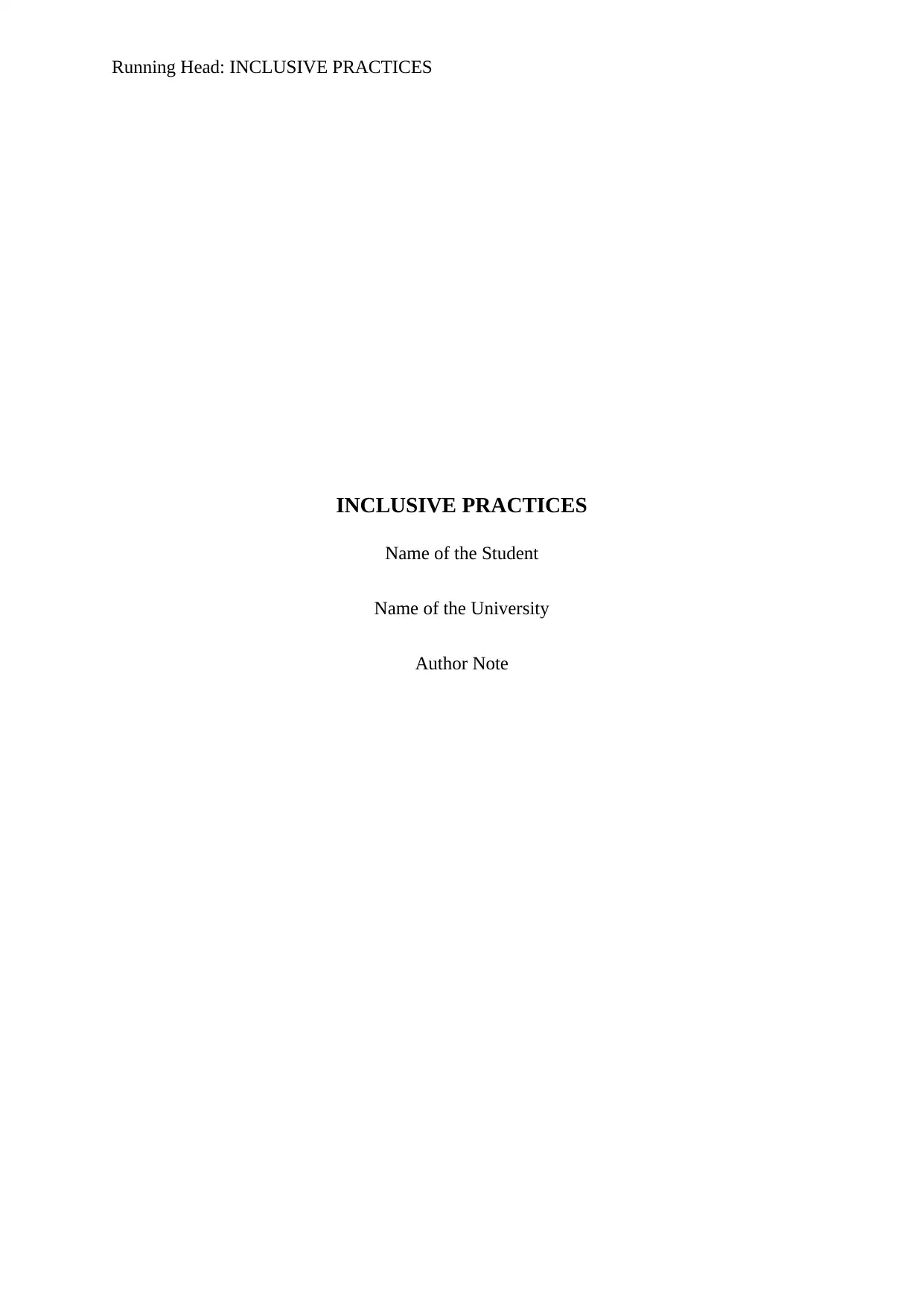
Running Head: INCLUSIVE PRACTICES
INCLUSIVE PRACTICES
Name of the Student
Name of the University
Author Note
INCLUSIVE PRACTICES
Name of the Student
Name of the University
Author Note
Paraphrase This Document
Need a fresh take? Get an instant paraphrase of this document with our AI Paraphraser
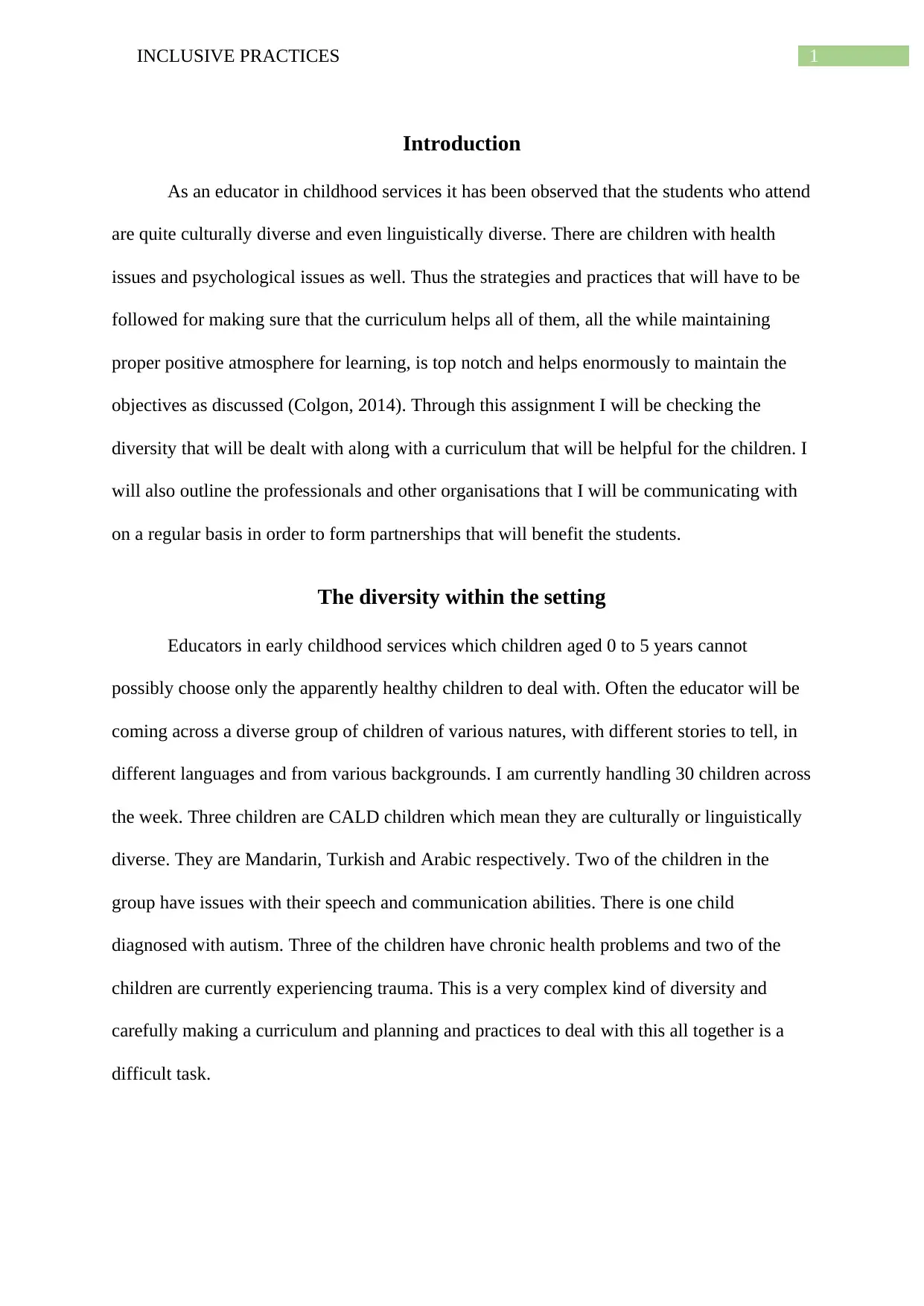
1INCLUSIVE PRACTICES
Introduction
As an educator in childhood services it has been observed that the students who attend
are quite culturally diverse and even linguistically diverse. There are children with health
issues and psychological issues as well. Thus the strategies and practices that will have to be
followed for making sure that the curriculum helps all of them, all the while maintaining
proper positive atmosphere for learning, is top notch and helps enormously to maintain the
objectives as discussed (Colgon, 2014). Through this assignment I will be checking the
diversity that will be dealt with along with a curriculum that will be helpful for the children. I
will also outline the professionals and other organisations that I will be communicating with
on a regular basis in order to form partnerships that will benefit the students.
The diversity within the setting
Educators in early childhood services which children aged 0 to 5 years cannot
possibly choose only the apparently healthy children to deal with. Often the educator will be
coming across a diverse group of children of various natures, with different stories to tell, in
different languages and from various backgrounds. I am currently handling 30 children across
the week. Three children are CALD children which mean they are culturally or linguistically
diverse. They are Mandarin, Turkish and Arabic respectively. Two of the children in the
group have issues with their speech and communication abilities. There is one child
diagnosed with autism. Three of the children have chronic health problems and two of the
children are currently experiencing trauma. This is a very complex kind of diversity and
carefully making a curriculum and planning and practices to deal with this all together is a
difficult task.
Introduction
As an educator in childhood services it has been observed that the students who attend
are quite culturally diverse and even linguistically diverse. There are children with health
issues and psychological issues as well. Thus the strategies and practices that will have to be
followed for making sure that the curriculum helps all of them, all the while maintaining
proper positive atmosphere for learning, is top notch and helps enormously to maintain the
objectives as discussed (Colgon, 2014). Through this assignment I will be checking the
diversity that will be dealt with along with a curriculum that will be helpful for the children. I
will also outline the professionals and other organisations that I will be communicating with
on a regular basis in order to form partnerships that will benefit the students.
The diversity within the setting
Educators in early childhood services which children aged 0 to 5 years cannot
possibly choose only the apparently healthy children to deal with. Often the educator will be
coming across a diverse group of children of various natures, with different stories to tell, in
different languages and from various backgrounds. I am currently handling 30 children across
the week. Three children are CALD children which mean they are culturally or linguistically
diverse. They are Mandarin, Turkish and Arabic respectively. Two of the children in the
group have issues with their speech and communication abilities. There is one child
diagnosed with autism. Three of the children have chronic health problems and two of the
children are currently experiencing trauma. This is a very complex kind of diversity and
carefully making a curriculum and planning and practices to deal with this all together is a
difficult task.
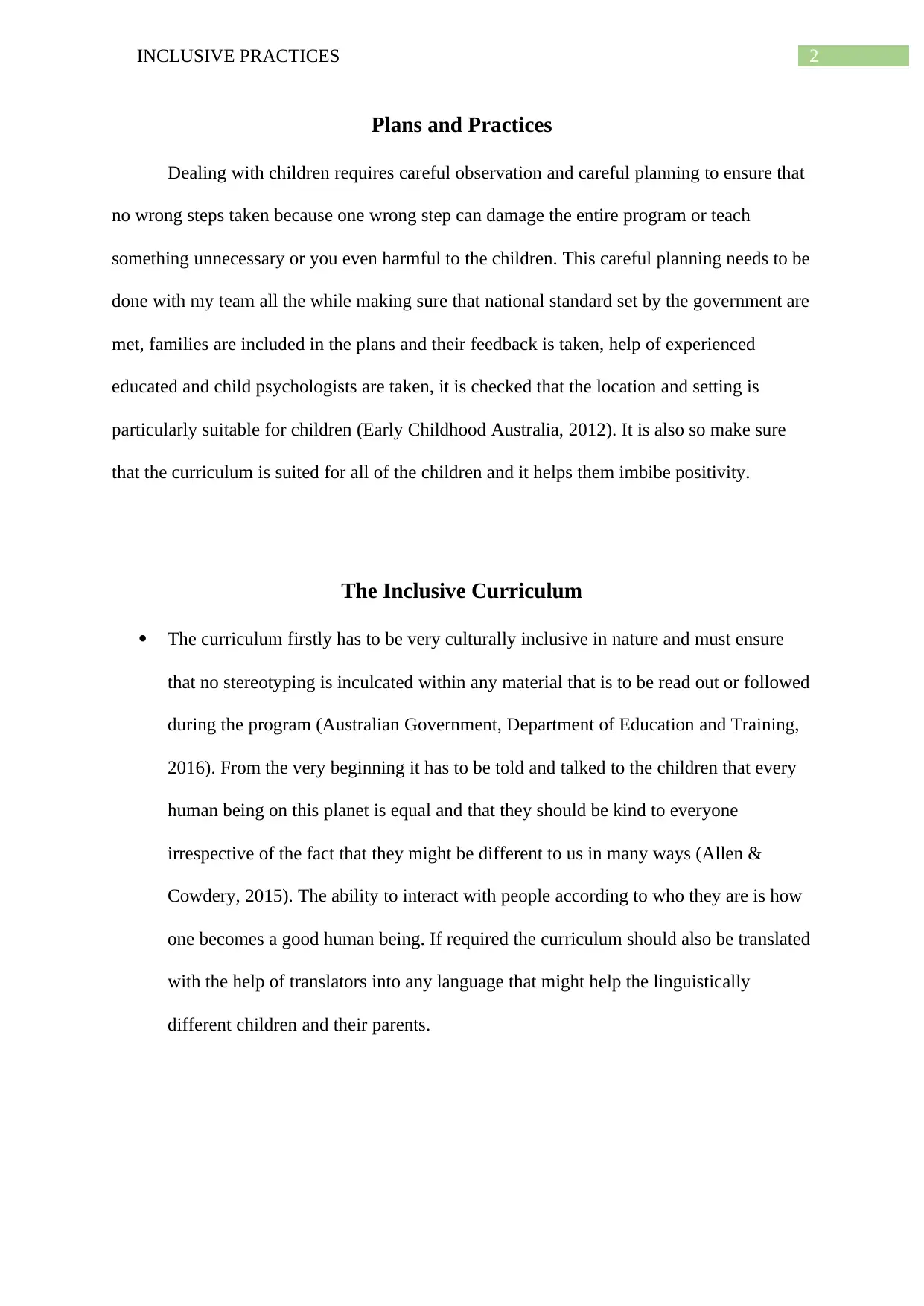
2INCLUSIVE PRACTICES
Plans and Practices
Dealing with children requires careful observation and careful planning to ensure that
no wrong steps taken because one wrong step can damage the entire program or teach
something unnecessary or you even harmful to the children. This careful planning needs to be
done with my team all the while making sure that national standard set by the government are
met, families are included in the plans and their feedback is taken, help of experienced
educated and child psychologists are taken, it is checked that the location and setting is
particularly suitable for children (Early Childhood Australia, 2012). It is also so make sure
that the curriculum is suited for all of the children and it helps them imbibe positivity.
The Inclusive Curriculum
The curriculum firstly has to be very culturally inclusive in nature and must ensure
that no stereotyping is inculcated within any material that is to be read out or followed
during the program (Australian Government, Department of Education and Training,
2016). From the very beginning it has to be told and talked to the children that every
human being on this planet is equal and that they should be kind to everyone
irrespective of the fact that they might be different to us in many ways (Allen &
Cowdery, 2015). The ability to interact with people according to who they are is how
one becomes a good human being. If required the curriculum should also be translated
with the help of translators into any language that might help the linguistically
different children and their parents.
Plans and Practices
Dealing with children requires careful observation and careful planning to ensure that
no wrong steps taken because one wrong step can damage the entire program or teach
something unnecessary or you even harmful to the children. This careful planning needs to be
done with my team all the while making sure that national standard set by the government are
met, families are included in the plans and their feedback is taken, help of experienced
educated and child psychologists are taken, it is checked that the location and setting is
particularly suitable for children (Early Childhood Australia, 2012). It is also so make sure
that the curriculum is suited for all of the children and it helps them imbibe positivity.
The Inclusive Curriculum
The curriculum firstly has to be very culturally inclusive in nature and must ensure
that no stereotyping is inculcated within any material that is to be read out or followed
during the program (Australian Government, Department of Education and Training,
2016). From the very beginning it has to be told and talked to the children that every
human being on this planet is equal and that they should be kind to everyone
irrespective of the fact that they might be different to us in many ways (Allen &
Cowdery, 2015). The ability to interact with people according to who they are is how
one becomes a good human being. If required the curriculum should also be translated
with the help of translators into any language that might help the linguistically
different children and their parents.
⊘ This is a preview!⊘
Do you want full access?
Subscribe today to unlock all pages.

Trusted by 1+ million students worldwide
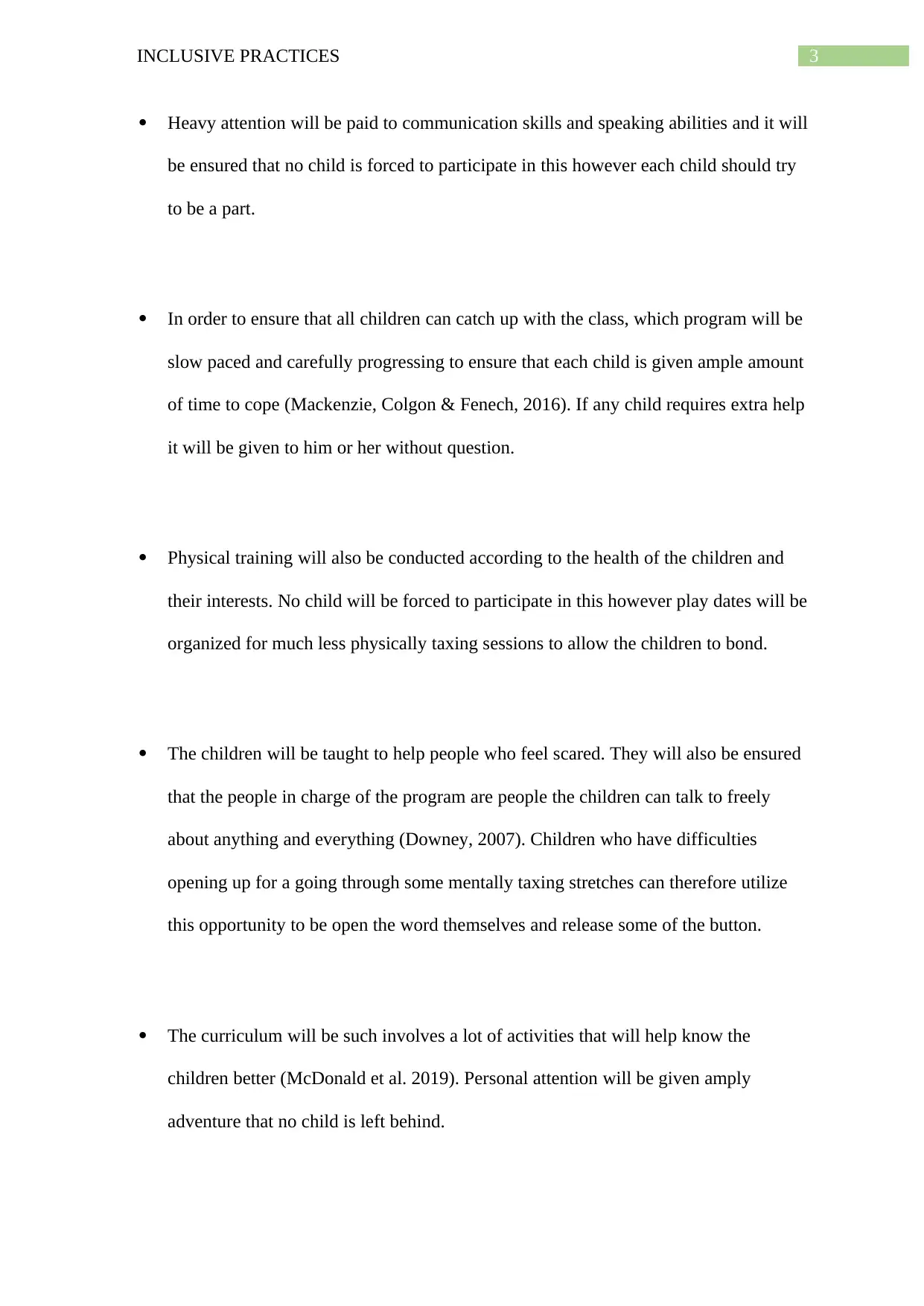
3INCLUSIVE PRACTICES
Heavy attention will be paid to communication skills and speaking abilities and it will
be ensured that no child is forced to participate in this however each child should try
to be a part.
In order to ensure that all children can catch up with the class, which program will be
slow paced and carefully progressing to ensure that each child is given ample amount
of time to cope (Mackenzie, Colgon & Fenech, 2016). If any child requires extra help
it will be given to him or her without question.
Physical training will also be conducted according to the health of the children and
their interests. No child will be forced to participate in this however play dates will be
organized for much less physically taxing sessions to allow the children to bond.
The children will be taught to help people who feel scared. They will also be ensured
that the people in charge of the program are people the children can talk to freely
about anything and everything (Downey, 2007). Children who have difficulties
opening up for a going through some mentally taxing stretches can therefore utilize
this opportunity to be open the word themselves and release some of the button.
The curriculum will be such involves a lot of activities that will help know the
children better (McDonald et al. 2019). Personal attention will be given amply
adventure that no child is left behind.
Heavy attention will be paid to communication skills and speaking abilities and it will
be ensured that no child is forced to participate in this however each child should try
to be a part.
In order to ensure that all children can catch up with the class, which program will be
slow paced and carefully progressing to ensure that each child is given ample amount
of time to cope (Mackenzie, Colgon & Fenech, 2016). If any child requires extra help
it will be given to him or her without question.
Physical training will also be conducted according to the health of the children and
their interests. No child will be forced to participate in this however play dates will be
organized for much less physically taxing sessions to allow the children to bond.
The children will be taught to help people who feel scared. They will also be ensured
that the people in charge of the program are people the children can talk to freely
about anything and everything (Downey, 2007). Children who have difficulties
opening up for a going through some mentally taxing stretches can therefore utilize
this opportunity to be open the word themselves and release some of the button.
The curriculum will be such involves a lot of activities that will help know the
children better (McDonald et al. 2019). Personal attention will be given amply
adventure that no child is left behind.
Paraphrase This Document
Need a fresh take? Get an instant paraphrase of this document with our AI Paraphraser
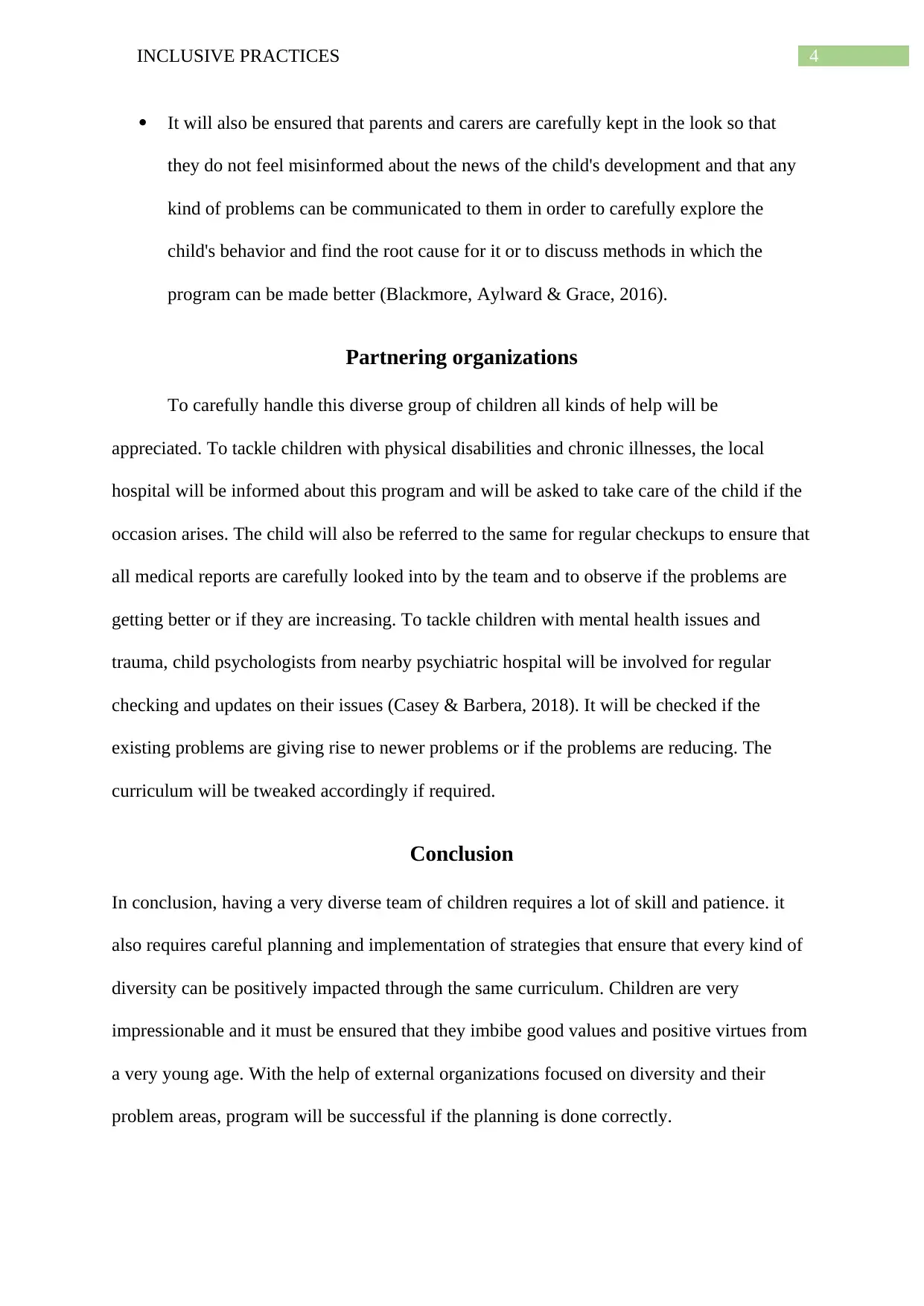
4INCLUSIVE PRACTICES
It will also be ensured that parents and carers are carefully kept in the look so that
they do not feel misinformed about the news of the child's development and that any
kind of problems can be communicated to them in order to carefully explore the
child's behavior and find the root cause for it or to discuss methods in which the
program can be made better (Blackmore, Aylward & Grace, 2016).
Partnering organizations
To carefully handle this diverse group of children all kinds of help will be
appreciated. To tackle children with physical disabilities and chronic illnesses, the local
hospital will be informed about this program and will be asked to take care of the child if the
occasion arises. The child will also be referred to the same for regular checkups to ensure that
all medical reports are carefully looked into by the team and to observe if the problems are
getting better or if they are increasing. To tackle children with mental health issues and
trauma, child psychologists from nearby psychiatric hospital will be involved for regular
checking and updates on their issues (Casey & Barbera, 2018). It will be checked if the
existing problems are giving rise to newer problems or if the problems are reducing. The
curriculum will be tweaked accordingly if required.
Conclusion
In conclusion, having a very diverse team of children requires a lot of skill and patience. it
also requires careful planning and implementation of strategies that ensure that every kind of
diversity can be positively impacted through the same curriculum. Children are very
impressionable and it must be ensured that they imbibe good values and positive virtues from
a very young age. With the help of external organizations focused on diversity and their
problem areas, program will be successful if the planning is done correctly.
It will also be ensured that parents and carers are carefully kept in the look so that
they do not feel misinformed about the news of the child's development and that any
kind of problems can be communicated to them in order to carefully explore the
child's behavior and find the root cause for it or to discuss methods in which the
program can be made better (Blackmore, Aylward & Grace, 2016).
Partnering organizations
To carefully handle this diverse group of children all kinds of help will be
appreciated. To tackle children with physical disabilities and chronic illnesses, the local
hospital will be informed about this program and will be asked to take care of the child if the
occasion arises. The child will also be referred to the same for regular checkups to ensure that
all medical reports are carefully looked into by the team and to observe if the problems are
getting better or if they are increasing. To tackle children with mental health issues and
trauma, child psychologists from nearby psychiatric hospital will be involved for regular
checking and updates on their issues (Casey & Barbera, 2018). It will be checked if the
existing problems are giving rise to newer problems or if the problems are reducing. The
curriculum will be tweaked accordingly if required.
Conclusion
In conclusion, having a very diverse team of children requires a lot of skill and patience. it
also requires careful planning and implementation of strategies that ensure that every kind of
diversity can be positively impacted through the same curriculum. Children are very
impressionable and it must be ensured that they imbibe good values and positive virtues from
a very young age. With the help of external organizations focused on diversity and their
problem areas, program will be successful if the planning is done correctly.
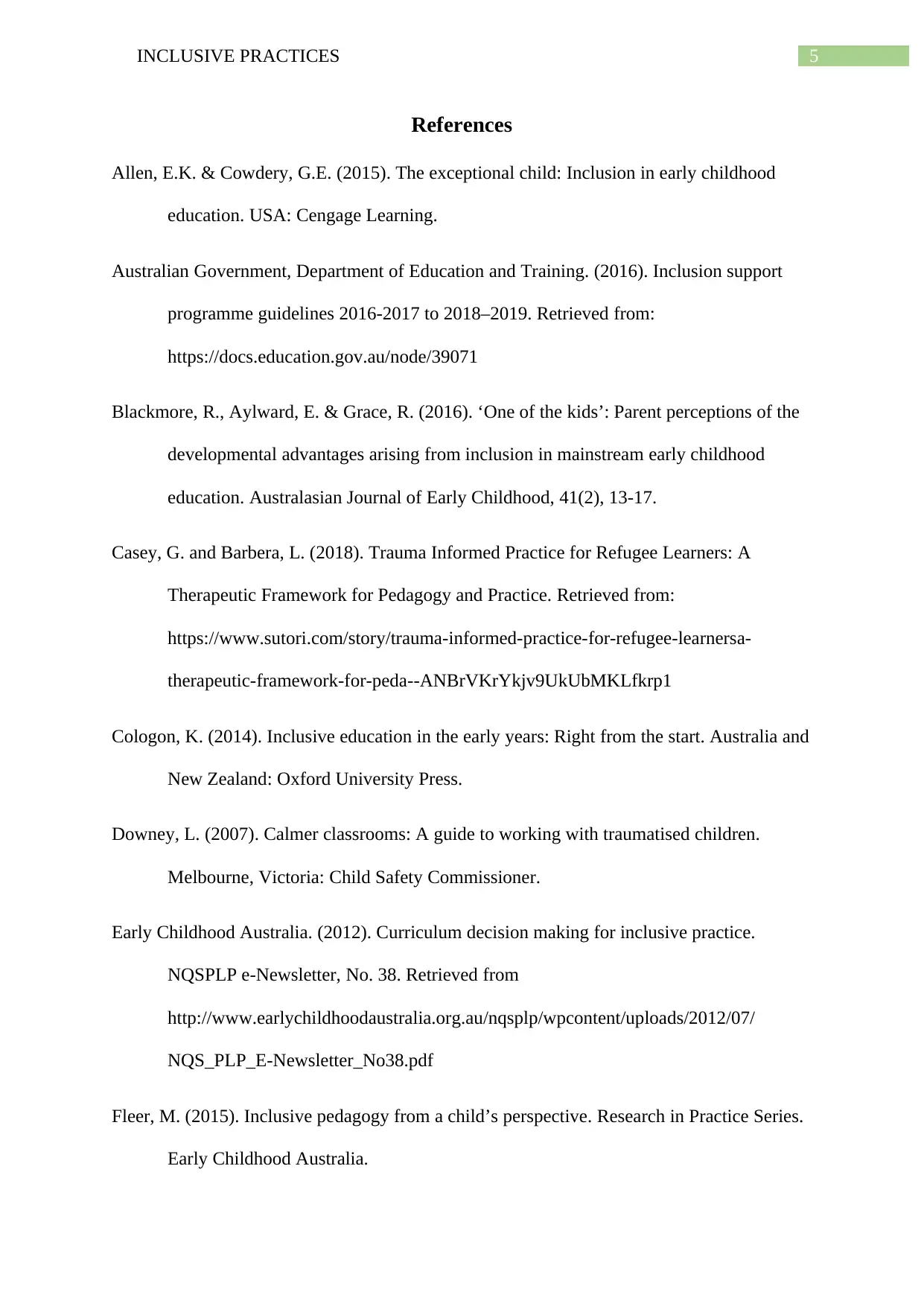
5INCLUSIVE PRACTICES
References
Allen, E.K. & Cowdery, G.E. (2015). The exceptional child: Inclusion in early childhood
education. USA: Cengage Learning.
Australian Government, Department of Education and Training. (2016). Inclusion support
programme guidelines 2016-2017 to 2018–2019. Retrieved from:
https://docs.education.gov.au/node/39071
Blackmore, R., Aylward, E. & Grace, R. (2016). ‘One of the kids’: Parent perceptions of the
developmental advantages arising from inclusion in mainstream early childhood
education. Australasian Journal of Early Childhood, 41(2), 13-17.
Casey, G. and Barbera, L. (2018). Trauma Informed Practice for Refugee Learners: A
Therapeutic Framework for Pedagogy and Practice. Retrieved from:
https://www.sutori.com/story/trauma-informed-practice-for-refugee-learnersa-
therapeutic-framework-for-peda--ANBrVKrYkjv9UkUbMKLfkrp1
Cologon, K. (2014). Inclusive education in the early years: Right from the start. Australia and
New Zealand: Oxford University Press.
Downey, L. (2007). Calmer classrooms: A guide to working with traumatised children.
Melbourne, Victoria: Child Safety Commissioner.
Early Childhood Australia. (2012). Curriculum decision making for inclusive practice.
NQSPLP e-Newsletter, No. 38. Retrieved from
http://www.earlychildhoodaustralia.org.au/nqsplp/wpcontent/uploads/2012/07/
NQS_PLP_E-Newsletter_No38.pdf
Fleer, M. (2015). Inclusive pedagogy from a child’s perspective. Research in Practice Series.
Early Childhood Australia.
References
Allen, E.K. & Cowdery, G.E. (2015). The exceptional child: Inclusion in early childhood
education. USA: Cengage Learning.
Australian Government, Department of Education and Training. (2016). Inclusion support
programme guidelines 2016-2017 to 2018–2019. Retrieved from:
https://docs.education.gov.au/node/39071
Blackmore, R., Aylward, E. & Grace, R. (2016). ‘One of the kids’: Parent perceptions of the
developmental advantages arising from inclusion in mainstream early childhood
education. Australasian Journal of Early Childhood, 41(2), 13-17.
Casey, G. and Barbera, L. (2018). Trauma Informed Practice for Refugee Learners: A
Therapeutic Framework for Pedagogy and Practice. Retrieved from:
https://www.sutori.com/story/trauma-informed-practice-for-refugee-learnersa-
therapeutic-framework-for-peda--ANBrVKrYkjv9UkUbMKLfkrp1
Cologon, K. (2014). Inclusive education in the early years: Right from the start. Australia and
New Zealand: Oxford University Press.
Downey, L. (2007). Calmer classrooms: A guide to working with traumatised children.
Melbourne, Victoria: Child Safety Commissioner.
Early Childhood Australia. (2012). Curriculum decision making for inclusive practice.
NQSPLP e-Newsletter, No. 38. Retrieved from
http://www.earlychildhoodaustralia.org.au/nqsplp/wpcontent/uploads/2012/07/
NQS_PLP_E-Newsletter_No38.pdf
Fleer, M. (2015). Inclusive pedagogy from a child’s perspective. Research in Practice Series.
Early Childhood Australia.
⊘ This is a preview!⊘
Do you want full access?
Subscribe today to unlock all pages.

Trusted by 1+ million students worldwide
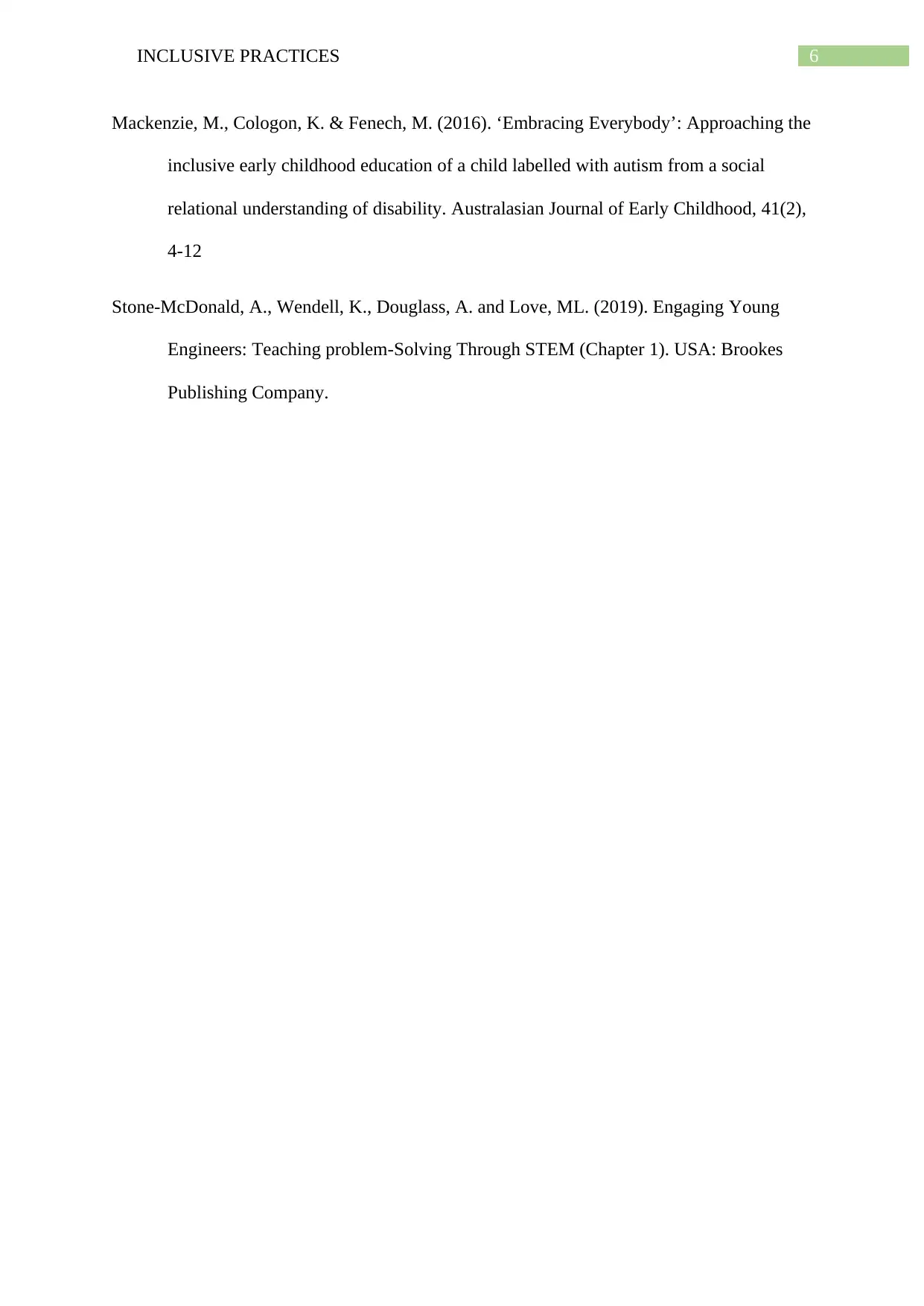
6INCLUSIVE PRACTICES
Mackenzie, M., Cologon, K. & Fenech, M. (2016). ‘Embracing Everybody’: Approaching the
inclusive early childhood education of a child labelled with autism from a social
relational understanding of disability. Australasian Journal of Early Childhood, 41(2),
4-12
Stone-McDonald, A., Wendell, K., Douglass, A. and Love, ML. (2019). Engaging Young
Engineers: Teaching problem-Solving Through STEM (Chapter 1). USA: Brookes
Publishing Company.
Mackenzie, M., Cologon, K. & Fenech, M. (2016). ‘Embracing Everybody’: Approaching the
inclusive early childhood education of a child labelled with autism from a social
relational understanding of disability. Australasian Journal of Early Childhood, 41(2),
4-12
Stone-McDonald, A., Wendell, K., Douglass, A. and Love, ML. (2019). Engaging Young
Engineers: Teaching problem-Solving Through STEM (Chapter 1). USA: Brookes
Publishing Company.
1 out of 7
Related Documents
Your All-in-One AI-Powered Toolkit for Academic Success.
+13062052269
info@desklib.com
Available 24*7 on WhatsApp / Email
![[object Object]](/_next/static/media/star-bottom.7253800d.svg)
Unlock your academic potential
Copyright © 2020–2025 A2Z Services. All Rights Reserved. Developed and managed by ZUCOL.





